Embark on a captivating exploration of Arkansas’s diverse birding scene with our comprehensive guide. This Ultimate Guide highlights the 37 most common birds found throughout the Natural State, offering insightful details on their habitats, behaviors, and unique attributes.
Whether you’re an avid birdwatcher, a nature lover, or simply curious about Arkansas’s rich birdlife, this guide provides a fascinating glimpse into the avian diversity that enriches this beautiful state.
Table of Contents
- 1 Most Common Birds in Arkansas
- 1.1 Northern Cardinal
- 1.2 Blue Jay
- 1.3 American Crow
- 1.4 Carolina Chickadee
- 1.5 Carolina Wren
- 1.6 Tufted Titmouse
- 1.7 Mourning Dove
- 1.8 Red-bellied Woodpecker
- 1.9 American Robin
- 1.10 Northern Mockingbird
- 1.11 Downy Woodpecker
- 1.12 Eastern Bluebird
- 1.13 White-throated Sparrow
- 1.14 European Starling
- 1.15 American Goldfinch
- 1.16 Red-winged Blackbird
- 1.17 White-breasted Nuthatch
- 1.18 Dark-eyed Junco
- 1.19 House Finch
- 1.20 House Sparrow
- 2 Frequently Asked Questions
- 2.1 What is the most common bird in Arkansas?
- 2.2 What bird is Arkansas known for?
- 2.3 What are the big black birds in Arkansas?
- 2.4 Are ravens in Arkansas?
- 2.5 Does Arkansas have grouse?
- 2.6 Are there roadrunners in Arkansas?
- 2.7 Are magpies in Arkansas?
- 2.8 Are grackles in Arkansas?
- 2.9 Are there falcons in Arkansas?
- 2.10 Do we have storks in Arkansas?
- 2.11 Are there cranes in Arkansas?
- 2.12 Do seagulls live in Arkansas?
- 2.13 Are there loons in Arkansas?
- 2.14 Are there pheasants in Arkansas?
- 3 Author
Most Common Birds in Arkansas
Northern Cardinal
The Northern Cardinal is a bird in the family Cardinalis, it’s also called the common cardinal. It can usually be seen in the southwestern part of the United States, including Texas, through the central United States to New Mexico, Oklahoma, Nebraska, Kansas, Montana, Wyoming, Idaho, California, Arizona, Colorado, Nevada, Arkansas, New Mexico, and Oregon.
They live in and around urban areas, and its winter range is limited to Alaska, but its spring migration can extend all the way to Canada. The birds are very beautiful and colorful, and their songs are usually quite soothing and pleasant to hear.
- Frequency: 62.64%
- Color: Mostly red with a black mask on the face, short pink bill
- Habitat: woodlands, gardens, parks, backyards, and wetlands
- Range: USA, Canada, Mexico
- Size: 8.2 – 9.3″ inches
- Weight: 33 – 65 grams
- Diet: Fruits, berries, and insects (grasshoppers, beetles, snails, cicadas)
- Family: Cardinalidae
- Genus: Cardinalis
- Maps: Range Map – Sightings Map
- Sounds: Calls and Songs
Related:
Blue Jay

Blue Jays are migratory birds that live in the Eastern and Central United States. Blue Jays are members of the Corvidae family, which includes crows and ravens. They live in temperate to subtropical regions of North America and can be found in forests, meadows, woodlands, scrublands, deserts and near human habitation.
Blue Jays are omnivores with a diet that consists mainly of seeds (including nuts), fruits (such as apples) insects such as caterpillars or beetles; they also eat other invertebrates such as spiders or earthworms.
Their migratory pattern is very variable; some blue jays migrate northward with winter’s arrival, while others remain in warmer climates year-round.
- Frequency: 51.92%
- Color: Blue crest on the head, wings, back, and tail, and has a white face and belly
- Habitat: Deciduous and mixed forests, mixed woodlands, backyards, parks
- Range: Southern Canada, Eastern and Central United States, Florida and Texas
- Size: 8 – 12″ inches
- Weight: 70 – 100 grams
- Diet: Nuts, seeds, caterpillars, grasshoppers, and beetles
- Family: Corvidae
- Genus: Cyanocitta
Related:
- How to Attract Blue Jays to your Yard?
- Do Blue Jays Migrate? The Truth
- What do Blue Jay Eat – All The Facts
American Crow
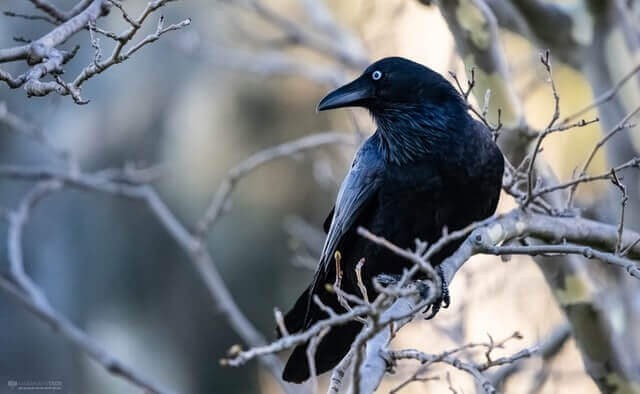
The American Crow is one of the most widespread and abundant birds in North America. They are found throughout much of the United States, Canada, Mexico and even as far south as Panama.
They are commonly seen near water sources such as rivers, lakes or coasts, but they are not dependent on them for survival. They live mostly in open country with scattered trees including parks, farmland and woodlands.
The diet of an American Crow consists mainly of small mammals, insects, carrion and eggs. In addition to this diet, crows also feed on acorns and corn during fall and winter months when other food sources are scarce. They migrate south for the winter and return north come springtime.
- Frequency: 47.61%
- Color: Black
- Habitat: Open country, farms, parks, woodlands, towns, cities
- Range: Canada, USA, Mexico
- Size: 16 – 21″ inches
- Weight: 315 -620 grams
- Diet: invertebrates, carrion, seeds, eggs fish, grains, mice, frogs, and other small animals.
- Family: Corvidae
- Genus: Corvis
Related: How To Attract Crows To Your Backyard: Expert Tips!
Carolina Chickadee
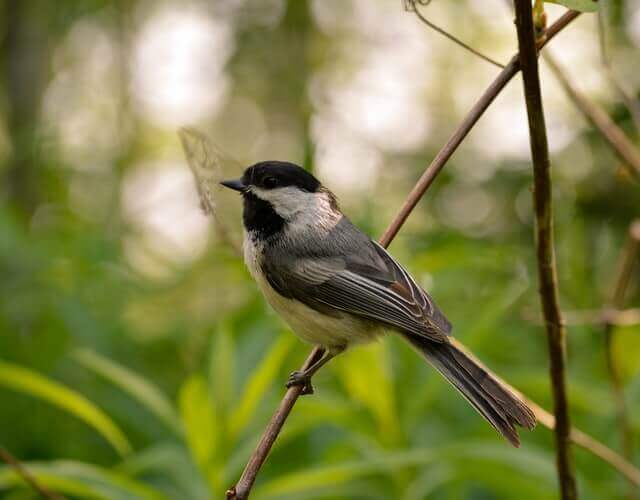
The Carolina Chickadee is a very small passerine bird belonging to the Paridae family in the order Passeriformes. The Carolina Chickadees are a type of small bird that have the black and white colors.
They are mainly found in North America and their range is from southern Canada to northern South America. The Carolina Chickadees habitat ranges throughout different types of areas, such as grasslands, shrub lands, wetlands, mixed forests or dry forests.
Carolina Chickadees diet consists of seeds, insects and spiders. They migrate south for wintertime when food becomes scarce.
- Frequency: 45.60%
- Color: Black cap and throat with white cheeks. Light gray wings, back, and tail.
- Habitat: Deciduous forests, suburbs, parks, backyards
- Range: USA ( Texas, Florida, New Jersey, and Kansas)
- Size: 4.5 – 5.1″ inches long
- Weight: 9 – 12 grams
- Diet: Insects, berries, seeds
- Family: Paridae
- Genus: Poecile
Related: Carolina Chickadees – 9 Best Ways To Attract Them Fast!
Carolina Wren
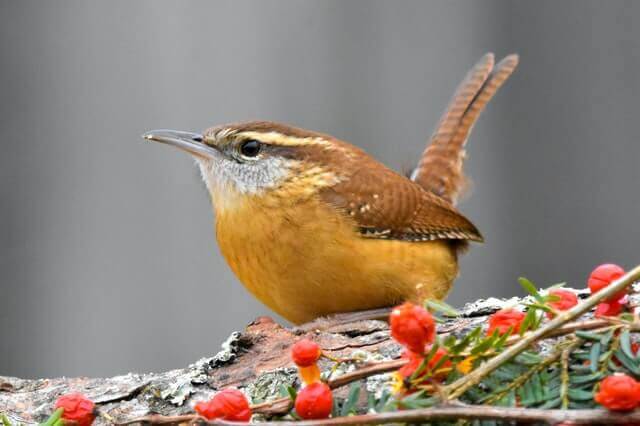
The Carolina Wren is a small, stocky songbird that resides in the eastern half of North America. The Carolina wren’s range includes most of the Eastern United States and southern Canada.
They are found in open country with dense undergrowth, hedges, or scrubby areas near water sources such as streams and ponds.
Their diet consists mostly of insects like caterpillars, beetles, ants and spiders as well as berries from many plants. They are one of the few birds that migrates during winter months for food sources.
- Frequency: 42.73%
- Color: reddish-brown upper and pale orange underneath, white eyebrow stripe, dark bill, white throat
- Habitat: Deciduous forests, suburbs, parks, backyards
- Range: USA ( Texas, Florida, New Jersey, and Kansas)
- Size: 4.5 – 5.1″ inches long
- Weight: 9 – 12 grams
- Diet: Insects, berries, seeds
- Family: Paridae
- Genus: Poecile
Related: How to Attract Wrens to your Backyard? (Expert’s Guide)
Tufted Titmouse
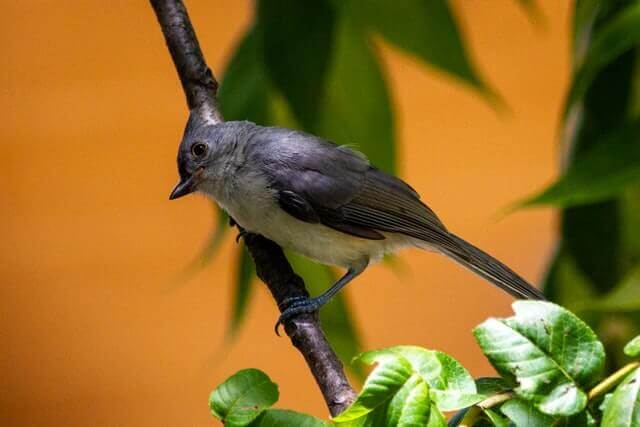
The Tufted Titmouse is a common species of bird found in North America. This small, lively songbird can be found across the eastern half of the United States and all but southern Texas, as well as parts of Eastern Canada.
They are usually found in mixed woodlands, forest edges and dense thickets. The titmouse has also been spotted in parks, suburbs and urban areas near woodland.
This bird feeds on insects such as caterpillars and beetles. They also feed on fruits like apples, berries, cherries and wild grapes. These birds are migratory, with some moving south during winter months and others remaining in the north. It ranges south into Texas during winter months and can be found as far west as Baja California Sur.
- Frequency: 42.68%
- Color: Gray upper, white front, a tufted gray crest on the head
- Habitat: Deciduous forests, river basin, backyards, swamps
- Range: Canada, USA, and Mexico
- Size: 5.5 – 6.4″ inches
- Weight: 18 – 26 grams
- Diet: Nuts, insects, berries, seeds small fruit, and snails
- Family: Paridae
- Genus: Baeolophus
Related: How to Attract Tufted Titmouse to my Yard
Mourning Dove
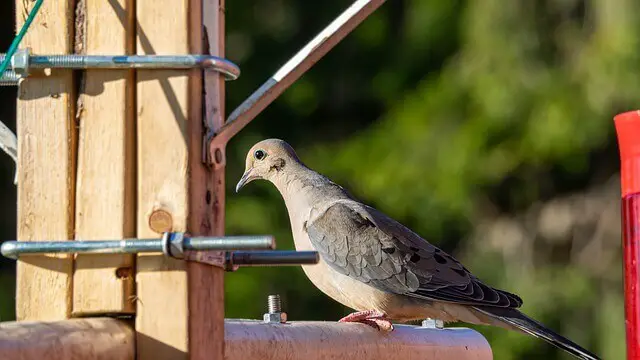
The Mourning Dove is an extremely colorful member of the family of passerine birds, Columbidae. The bird is commonly known as the American mourning dove and has been referred to as the Carolina bird, the rain dove and colloquially the turtle bird. It is one of North America’s most widespread and abundant species.
You will find this species in the southern parts of Arkansas. Some of its known for breeding in the Arkansas River Valley, but many have been seen flying in and out of the trees and around houses.
There are two main seasons of this bird’s life cycle: the winter season, which lasts from January through March, and the summer season, which lasts from June through August. Both male and female Mourning Doves can mate year-round. Mating takes place in springtime in the northern hemisphere and summer in the southern hemisphere. The mating season is highly dependent upon where the bird resides.
- Frequency: 41.91%
- Color: Light gray-brown and lighter and pinkish below. The wings have black spots.
- Habitat: Open habitats, urban areas, farms, prairie, grassland, wooded area
- Range: USA, Canada, Mexico, Central America, Greater Antilles
- Size: 12″ inches length
- Weight: 112 – 170 grams
- Diet: Rapeseed, corn, millet, safflower, sunflower seeds, pokeberry, sesame, and wheat.
- Family: Columbidae
- Genus: Zenaida
Related:
- Best Bird Feeder For Doves (Reviewed & Tested for 2022)
- Facts About Mourning Doves – 10 Things You Need To Know!
Red-bellied Woodpecker
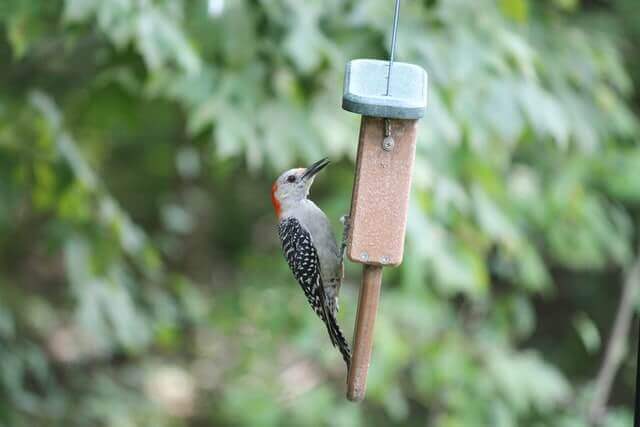
The red-bellied woodpecker is a type of bird found in North America. They live throughout the southeastern United States and east of the Rocky Mountains. Their range extends from Maine to eastern Texas in the north, down to Georgia on the coast, as well as west to Kansas City on both coasts.
Its habitat is primarily on large pieces of dead and fallen trees in boreal forests, or deciduous forests with mature trees. The woodpeckers usually build their nests on the underside of the tree, or on the trunk of the tree.
The birds have an extensive diet that includes insects like ants, beetles and caterpillars; but they will also eat nuts from acorns, beechnuts and walnuts; fruit like cherries, and berries.
- Frequency: 40.94%
- Color: Gray on body and face and underparts. Black and white pattern on wings, back, and tail.
- Habitat: Forests, backyards
- Range: Southern Canada, Eastern United States, Florida
- Size: 9 – 10.6″ inches long
- Weight: 56 -91 grams
- Diet: Insects, tree frogs, eggs of small birds, oozing sap, and small fish.
- Family: Picidae
- Genus: Melanerpes
Related: How to Attract Red-bellied Woodpeckers to your Yard?
American Robin
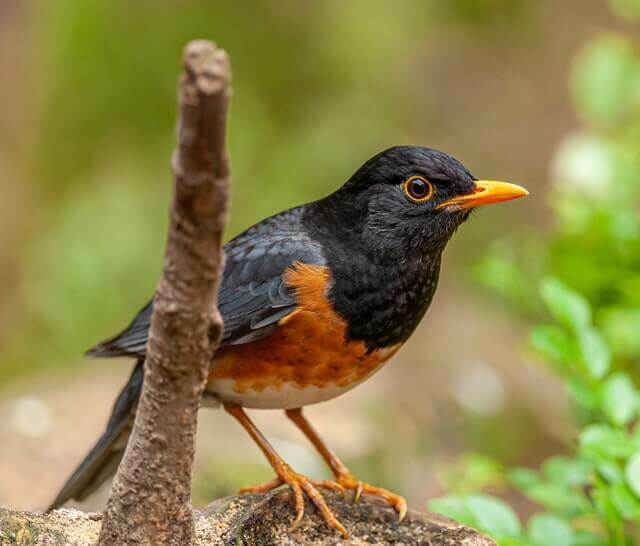
The American Robin is a medium-sized songbird in the Turdidae family, native to North America. This species ranges from Alaska, Canada and the Eastern United States south to Mexico and Cuba.
They are found in woodlands, parks, suburban areas and rural areas where there are trees or shrubs for nesting. The American Robin has a varied diet of earthworms, caterpillars, grasshoppers, spiders and berries; they also eat some fruits such as blackberries. They migrate during winter to warmer climates like Mexico and Southern California.
It can be seen year-round in the north and south of the continent, but moves to warmer climates during winter months. They migrate long distances every year from central Canada to South America and back again, following different routes that are determined by their location on the continent.
- Frequency: 33.43%
- Color: Mostly brown on the back with an orange-colored breast
- Habitat: Wooded areas, backyards, parks, fields
- Range: USA, Canada, Mexico
- Size: 12 – 16″ inches in length
- Weight: 72 – 95 grams
- Diet: Fruits, berries, and insects (earthworms, beetles, caterpillars
- Family: Turdidae
- Genus: Turdus
Related: Interesting American Robin Fun Facts
Northern Mockingbird
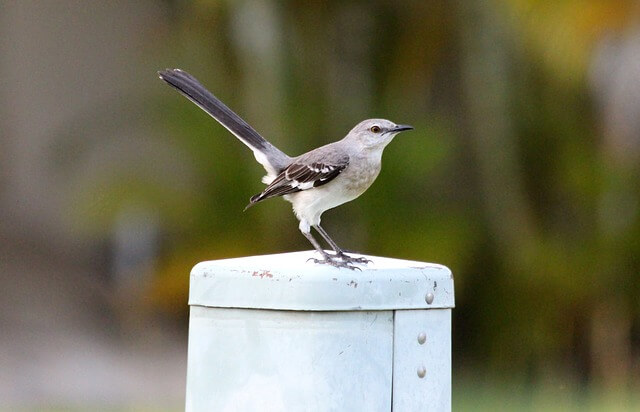
The Northern Mockingbird is found throughout the eastern United States and has a distinctive white eye ring. The bird’s range includes Florida, Louisiana, Mississippi, Arkansas, Oklahoma and Texas in the south to Maine and Ontario in Canada.
They can be found in habitats such as woodlands with shrubs or trees for nesting sites. Mockingbirds eat mostly insects, but also enjoy fruits such as mulberries and blackberries.
Mockingbirds are migratory birds that fly south from September through November and north from March through May.
- Frequency: 32.41%
- Color: Gray upper with white underparts. Black and white wing bars.
- Habitat: Forested areas, parks, and gardens
- Range: Southeastern Canada, USA, Northern Mexico, Cayman Islands, Greater Antilles
- Size: 8.0 – 11″ inches long
- Weight: 40 – 58 grams
- Diet: Berries, fruits, seeds, arthropods, earthworms, and occasionally lizards
- Family: Mimidae
- Genus: Mimus
Related: How to Attract Mockingbirds to your Yard? (Expert Tips)
Downy Woodpecker
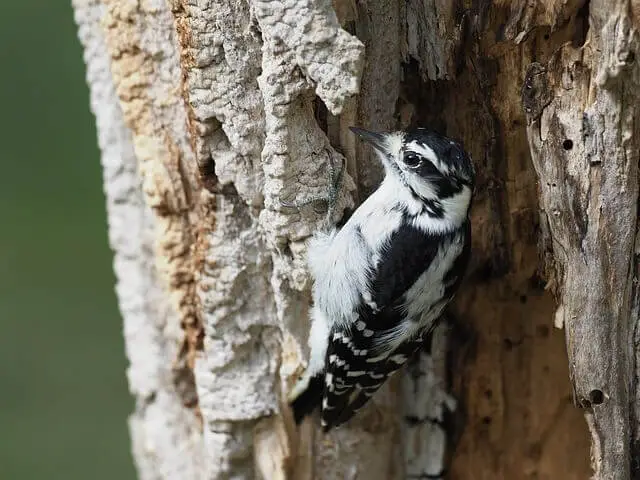
The Downy Woodpecker is a small bird that lives in North America. It is mostly found east of the Rocky Mountains and west of the Mississippi River.
They live in deciduous forests, old fields, farmlands and suburban areas where there are many trees for them to build their nests. Downy Woodpeckers eat insects like ants, beetles, bees and wasps, and they also enjoy eating seeds from plants such as sunflowers or corn cobs if they find them.
They also feed on tree sap during the winter months, when insects are scarce or buried deep in bark crevices. They have an annual migration pattern which varies depending on climate zones.
- Frequency: 32.38%
- Color: Black with a white throat, belly, and back. White spots on wings
- Habitat: Deciduous forests and thickets, roadside, grasslands, backyards, parks
- Range: Canada, USA, and Mexico
- Size: 5.5 – 7.1″ inches in length
- Weight: 20 – 33 grams
- Diet: Mostly insects and beetles and ants, also gall wasps, caterpillars
- Family: Picadae
- Genus: Dryobates
Related: How to Attract Downy Woodpeckers to Your Yard? (Easy!)
Eastern Bluebird
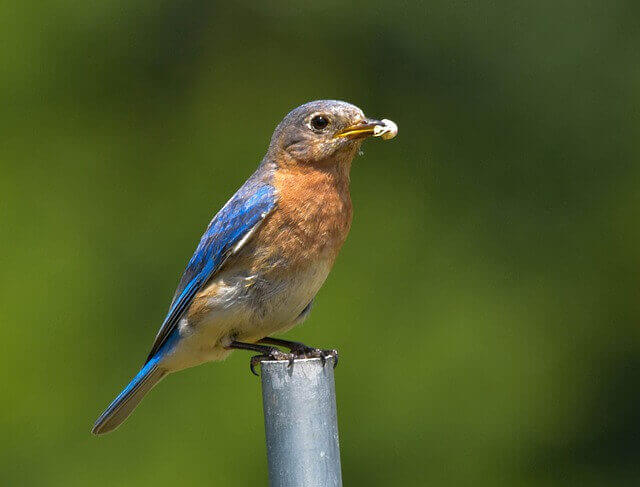
The Eastern Bluebird is a species of bluebird that inhabits much of the eastern United States. It breeds from eastern Canada to Florida, along the Appalachian Mountains range of New England and south through West Virginia, Tennessee, Kentucky, northern Georgia and Alabama into central Mississippi.
During winter, they stay in various parts of North America, especially in the states of Arkansas, Maine, Massachusetts, and Vermont. They are found in woodlands, forests and rural areas with open ground for nesting. Eastern Bluebirds mainly eat insects like beetles, grass hoppers, crickets and caterpillars, but will also consume berries, fruit and seeds.
Eastern Bluebirds breed primarily from March to July, and they will nest on or near the ground under dense shrubs or bushes. Males attract females by singing from perches close to potential nest sites, which can include utility poles, and fence. They migrate south during winter but have a shorter migration distance than other birds due to their small size.
- Frequency: 27.54%
- Color: A blue head, back, and wings with reddish-brown breast.
- Habitat: Open woodlands, farmlands, and orchards.
- Range: Southern Canada to the Gulf states, East of the Rockies and south to Arizona to Nicaragua.
- Size: 5.5 – 7.1″ inches in length
- Weight: 20 – 33 grams
- Diet: insects and other invertebrates
- Family: Turdidae
- Genus: Sialia
Related: How to Attract Eastern Bluebirds to your Yard (Explained)
White-throated Sparrow

The White-throated Sparrow is a common songbird found in North America. It ranges from Alaska to the southeastern coast of Canada and southward through the eastern United States, Central America, Mexico and Central America into South America.
They typically reside in grasslands or thickets near water sources and marshes but can also be found in meadows, forests, pastures or even urban areas like parks. The diet consists mostly of insects with occasional berries and seeds being eaten as well.
The white-throated sparrow migrates as far south as Argentina in winter months when it feeds on crops before returning north in the spring.
- Frequency: 27.40%
- Color: Brown and gray head pattern. Black-and-white-striped head, white throat, and some yellow near the eye.
- Habitat: Deciduous forests and thickets, roadside, grasslands, backyards
- Range: Eastern North America, Atlantic Canada
- Size: 5.9″ – 7.5″ inches long
- Weight: 22 – 32 grams
- Diet: Seeds, insects, and berries
- Family: Passerellidae
- Genus: Zonotrichia
European Starling
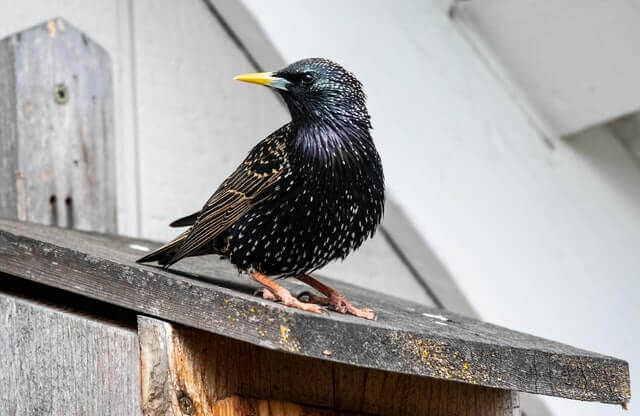
The European Starling is a medium-sized passerine bird that is native to Europe and parts of Asia. They are also found in Africa, North America, and South America.
They live year round in southernmost Sweden (where they only exist during the winter), as well as Norway, where they do not migrate south for the winter. European starlings are omnivores, eating a wide range of insects, earthworms, fruits and berries, seeds and cereal grains.
They are ground feeders that often forage among hedgerows or close to human habitation. They will roost communally in trees at night, but usually nest individually or in small groups on building ledges.
- Frequency: 25.31%
- Color: Black with glossy iridescence plumage
- Habitat: Forests, woodlands, backyards, edges, yards, and parks
- Range: North America, Europe, Africa, India, Middle East, China
- Size: 7 – 9″ inches long
- Weight: 60 – 100 grams
- Diet: Insects (ants, beetles, invertebrates), fruits, seeds, berries
- Family: Sturnidae
- Genus: Colaptes
Related: How To Attract European Starlings To Your Yard Fast?
American Goldfinch
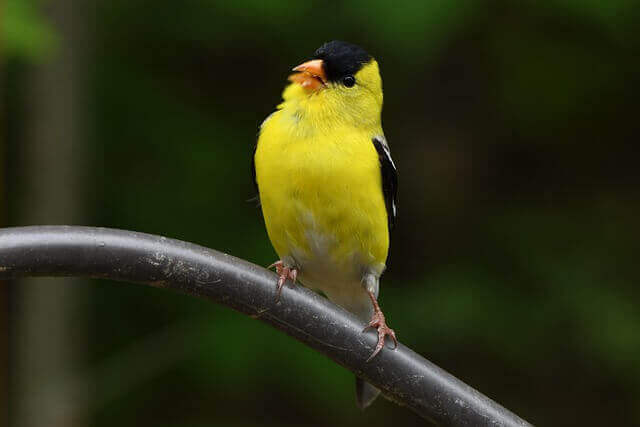
The American Goldfinches are a small, medium-sized songbird. They can be found in North America and have been observed throughout the continent. The range of this species includes Canada, United States, Mexico and Central America.
The habitat of these birds ranges from urban areas to natural habitats such as coniferous forests, deciduous woodlands, open areas, orchard edges and farmlands or chaparral scrubland which can be dry or wet savannahs too.
Their diet consists mainly of seeds, but they also eat insects like aphids from time to time. Their migration pattern varies depending on the season; some migrate to South America, while others migrate to the southern United States.
- Frequency: 23.43%
- Color: Face, neck, and underside are yellow, black wings with white bars
- Habitat: Deciduous forests and thickets, roadside, grasslands, backyards, meadows
- Range: Canada, USA, and Mexico
- Size: 4.3 – 5.5″ inches length
- Weight: 12 -18 grams
- Diet: Grass, dandelions, chickweed, sunflowers and ragweed, thistle, red alder, birch, spruce seeds
- Family: Fringillidae
- Genus: Spinus
Related: American Goldfinch Interesting Facts
Red-winged Blackbird
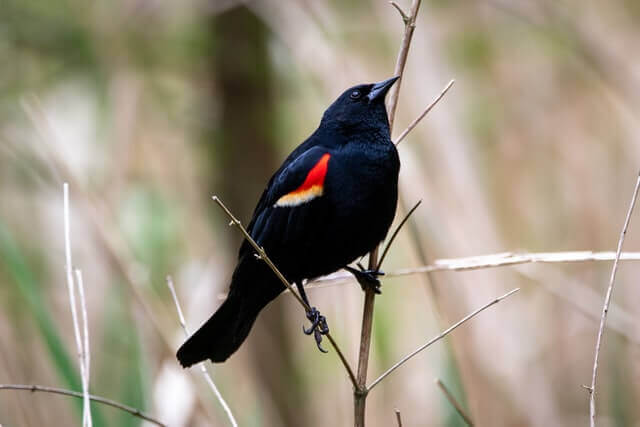
The red-winged Blackbird is an arboreal passerine bird belonging to the family Icteriae found throughout North America and parts of Central America. Its preferred habitat is primarily in dry or deciduous forests and is often associated with forest edges or other open areas where it has access to water.
Although the birds are relatively abundant in large numbers throughout most of the United States, they are particularly abundant in the western part of its range. The bird’s natural habitat is mostly woodland and swamps.
The bird can also be found on a small variety of trees and shrubs in urban areas and in fields. The migration season is from April to November.
There is a seasonal migration called the winter migration that may take the bird from central and south-eastern United States to Canada. The bird usually returns to its wintering grounds after nesting.
- Frequency: 22.31%
- Color: All black with red patches on shoulder and a yellow wing bar
- Habitat: Deciduous forests, conifers, roadside, rivers, backyards, parks
- Range: North America, Central America
- Size: 6.7 – 7.1″ inches length
- Weight: 41.5 – 65 grams
- Diet: Seeds and insects (butterflies, dragonflies, moths, frogs, worms, spiders, snails, carrion, flies.)
- Family: Icteridae
- Genus: Agelaius
White-breasted Nuthatch
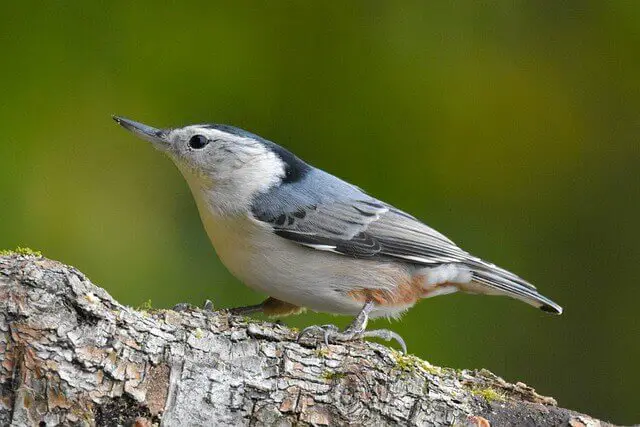
The common white-breasted nuthatches are in fact a member of the nuthatches family found across North and South America.
Nuthatches have a very diverse diet. The nuthatches’ main food source is the larvae, or caterpillars, of moths, grasshoppers, beetles, wasps, grasshoppers, lacewings, flies, aphids, roaches, lacewings, whiteflies, lacewings, leafhoppers, mosquitoes, dragonflies, and lacewings.
White-breasted nuthatches can be seen anywhere in the United States and Canada from the southern plains through the deep south into the central states. Some nuthatches may even be seen as far west as the Great Plains. If you’re lucky enough to come across one, you can be assured of a wonderful, if not spectacular, encounter.
- Frequency: 19.97%
- Color: Has a white face, flanks, and chest. It has a black cap on its head a bluish-gray upper and a brown belly
- Habitat: Deciduous forests, conifers, roadside, rivers, backyards, parks
- Range: Southern Canada, USA
- Size: 5.9″ inches
- Weight: 20 grams
- Diet: Acorn nuts, hickory nuts, ants, caterpillars, scale insects, pine weevils
- Family: Sittidae
- Genus: Sitta
Related: How to Attract Nuthatches to your Backyard
Dark-eyed Junco
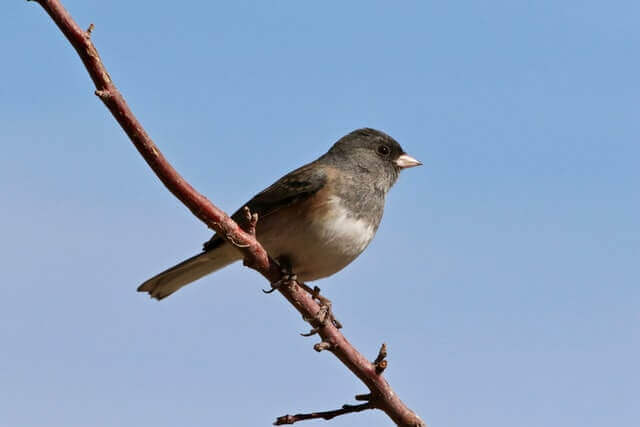
The Dark-eyed Junco is a bird that is native to North America. They live in coniferous forests, meadows and mixed deciduous woods from the eastern coast of Canada to central Mexico. Their diet consists mostly of small insects such as grasshoppers, crickets and beetles, with some seeds on occasion.
In winter, they will migrate southwards to escape cold weather for warmer climates or seek out habitats that offer food sources during this time period, such as citrus groves or chaparral.
The bird can be heard in the spring in many parts of the southern United States but is most commonly found in Florida, Texas, California, Washington, Oregon, the British Columbia, and New Mexico. The bird also makes a large amount of migration and winter migration to Canada and Europe.
- Frequency: 19.90%
- Color: Gray head, neck, breast, gray/brown backs and wings, white underside
- Habitat: Wooded areas, forest edges, roadsides, gardens, parks.
- Range: USA and Canada
- Size: 5.1 – 6.9″ inches
- Weight: 18 – 30 grams
- Diet: Seeds, insects, and arthropods
- Family: Passeriformes
- Genus: Junco
Related: Fun Facts About Dark-eyed Juncos
House Finch
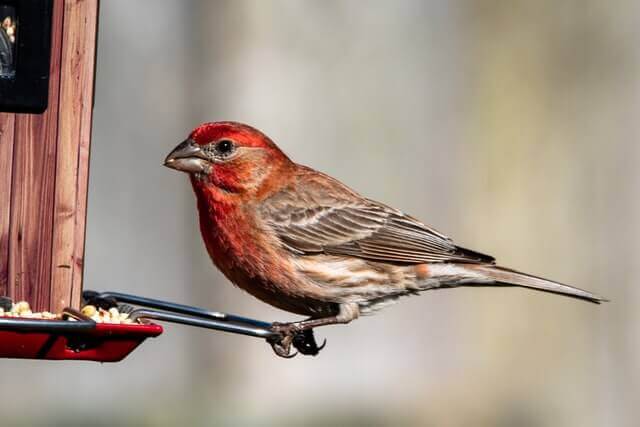
The House Finch is a small songbird, the size of a sparrow. It has been found to have an extensive range in North America. They can be found throughout most of Canada and the United States, as well as Central America, South America and northern Mexico.
The range extends from Southern California to Florida, and then into Texas, Louisiana, Oklahoma, Arkansas and Tennessee. They have been found all over the country, but they are not common everywhere. Their habitats can be anywhere from open woodlands to wetland areas near water sources such as streams or ponds.
The diet of these birds consists mainly of seeds, grains, berries, fruits and insects; however they are omnivores so will eat anything they can find. House Finches are migratory birds which means they spend the winter months south of the equator in Mexico and Central America while spending summers north of the equator for breeding season.
- Frequency: 19.52%
- Color: Reddish face and upper breast, brown streaks on back, belly, and tail.
- Habitat: urban and suburban areas, backyards, edges, yards, and parks
- Range: Canada, USA, Mexico
- Size: 5 – 6″ inches
- Weight: 16 – 27 grams
- Diet: Aphids, grains, seeds, berries, nettle, dandelion, sunflower
- Family: Fringillidae
- Genus: Haemorhous
Related: How to Attract House Finch to your Yard
House Sparrow
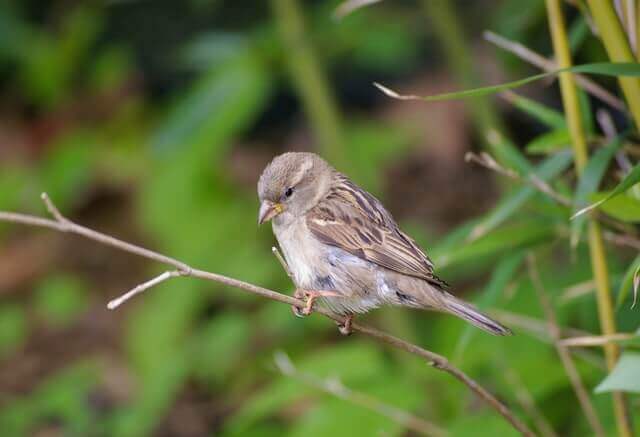
The house sparrow is a small bird with a long tail that can be found in most parts of the world except for Antarctica. The range includes Africa, Asia, Europe and North America as well as Australia and New Zealand.
They are typically found in open habitats such as farmland or parks where they feed mainly on seeds but also insects, scraps from human meals and cereal grain crops that it pulls up from the ground using its beak for these purposes.
In winter, these sparrows migrate southwards where they inhabit open habitats such as fields with short grasses or agricultural land.
- Frequency: 19.00%
- Color: Gray head marking, a reddish-brown back, and gray underparts
- Habitat: Urban centers, suburban areas, backyards, edges, yards, and parks
- Range: North America, Central America, South America, Africa, Australia, New Zealand
- Size: 5.5 – 7.1″ inches in length
- Weight: 25 – 39 grams
- Diet: Insects, beetles, caterpillars, aphids,, grasshoppers, crustaceans, earthworms, vertebrates
- Family: Passeridea
- Genus: Passer
Related: How to Attract Sparrows to your Backyard
The Backyard Birds below have a Frequency of less than 19% all year-round
- Northern Flicker 18.86% Frequency
- Common Grackle 17.84%
- Brown Thrasher 16.31%
- Brown-headed Cowbird 16.21%
- Indigo Bunting 16.11%
- Eastern Phoebe 15.26%
- Pileated Woodpecker 15.23%
- Killdeer 14.74%
- Ruby-throated Hummingbird 13.63%
- Eastern Meadowlark 12.74%
- Yellow-rumped Warbler 12.63%
- Pine Warbler 11.34%
- Blue-gray Gnatcatcher 11.00%
- Chipping Sparrow 10.57%
- White-eyed Vireo 10.47%
- Summer Tanager 10.32%
- Barn Swallow 10.04%
Frequently Asked Questions
What is the most common bird in Arkansas?
Of the 429 bird species that have been recorded in Arkansas, the Northern Cardinal is by far the most common, with a 63 percent frequency of occurrence. This vibrant red bird is a fixture in many backyard birding setups across the state and beyond, and its beautiful song is a welcome addition to any summer day.
What bird is Arkansas known for?
The northern mockingbird is Arkansas’s official state bird. It was first named so on March 5, 1929. The northern mockingbird is known for its uncanny ability to sound like a human and animal. It is also known for the bright, reassuring melody it sings.
What are the big black birds in Arkansas?
There are two species of blackbirds that are commonly seen in Arkansas: the American crow and the fish crow. Both of these birds are members of the Corvidae family, which also includes ravens, jays, and magpies.
Are ravens in Arkansas?
There are no ravens in Arkansas. Ravens only appear in the northern states. Some people believe that they have seen a raven in Arkansas, but it is most likely a crow. Ravens are larger than crows and have a different call.
Does Arkansas have grouse?
In Arkansas, the Ruffed Grouse is the only grouse species that is found. The Ruffed Grouse inhabits forests with dense undergrowth, such as young forests or regenerating forests. It feeds on buds, twigs, leaves, berries, and insects. In Arkansas, the Ruffed Grouse is found in the Ozark Mountains and in the Ouachita Mountains.
Are there roadrunners in Arkansas?
There is only one species of roadrunner found in Arkansas, the Greater Roadrunner. These birds are not often seen in the state, but there have been a few sightings reported. The roadrunner is a member of the cuckoo family and is native to North and South America. The bird is named for its habit of running after prey, rather than flying after it. The roadrunner can run up to 20 miles per hour and has been known to kill rattlesnakes.
Are magpies in Arkansas?
There are no known populations of magpies in Arkansas. The state is home to many different species of birds, but the magpie is not one of them. There are a number of reasons for this. First, Arkansas is not located in the natural range of the magpie. Second, the climate of Arkansas is not conducive to the survival of the magpie.
Are grackles in Arkansas?
Yes, both common grackles and Great-tailed Grackles are found in Arkansas. The common grackle is a widespread bird that is often seen in urban areas, while the Great-tailed Grackle is more likely to be found in rural areas. Both species are members of the family Icteridae, which includes other blackbirds, orioles, and meadowlarks.
Are there falcons in Arkansas?
There are two species of falcons found in Arkansas are the Peregrine falcon and the Prairie falcon. The Peregrine falcon is the more common of the two, and can be found in all 75 counties of Arkansas. The Prairie falcon is less common, and is only found in a few counties in the northwest corner of the state.
Do we have storks in Arkansas?
Yes, there are wood storks in Arkansas. These large wading birds can be found in the southern and eastern parts of the state, near swamps, rivers, and lakes. They are the only species of stork that breeds in North America. These birds build their nests in trees, often near water.
Are there cranes in Arkansas?
The sandhill crane and whooping crane are two species of crane that can be found in Arkansas. The sandhill crane is the most common type of crane in the state, and can be found in wooded areas near lakes and marshes. The whooping crane is a less common sight, but can occasionally be seen in fields and wetlands.
Do seagulls live in Arkansas?
There are 15 species of gulls that have been documented in Arkansas. The most common gull in the state is the ring-billed gull. Gulls are generally found near large bodies of water, but they can also be found in farmland and other open areas. Gulls typically eat small fish, crustaceans, and insects.
Are there loons in Arkansas?
There are four species of loons that have been documented in Arkansas: the common loon, the red-throated loon, the Pacific loon, and the yellow-billed loon.
The common loon is the most widely distributed of the four species, and is frequently seen in Arkansas during the summer months. The red-throated loon is less common, but can occasionally be seen on larger bodies of water in the state. The Pacific loon is a rare visitor to Arkansas, but has been documented on occasion. The yellow-billed loon is the least likely of the four species to be seen in Arkansas, but there have been a few sightings over the years.
Are there pheasants in Arkansas?
Yes, there are pheasants in Arkansas. The only species is the Ring-necked Pheasant. They are not native to Arkansas, but were introduced in the early 1900s for hunting purposes. Today, they can be found in all 75 counties of Arkansas. While their populations have declined in recent years, they are still a popular game bird for hunters.



